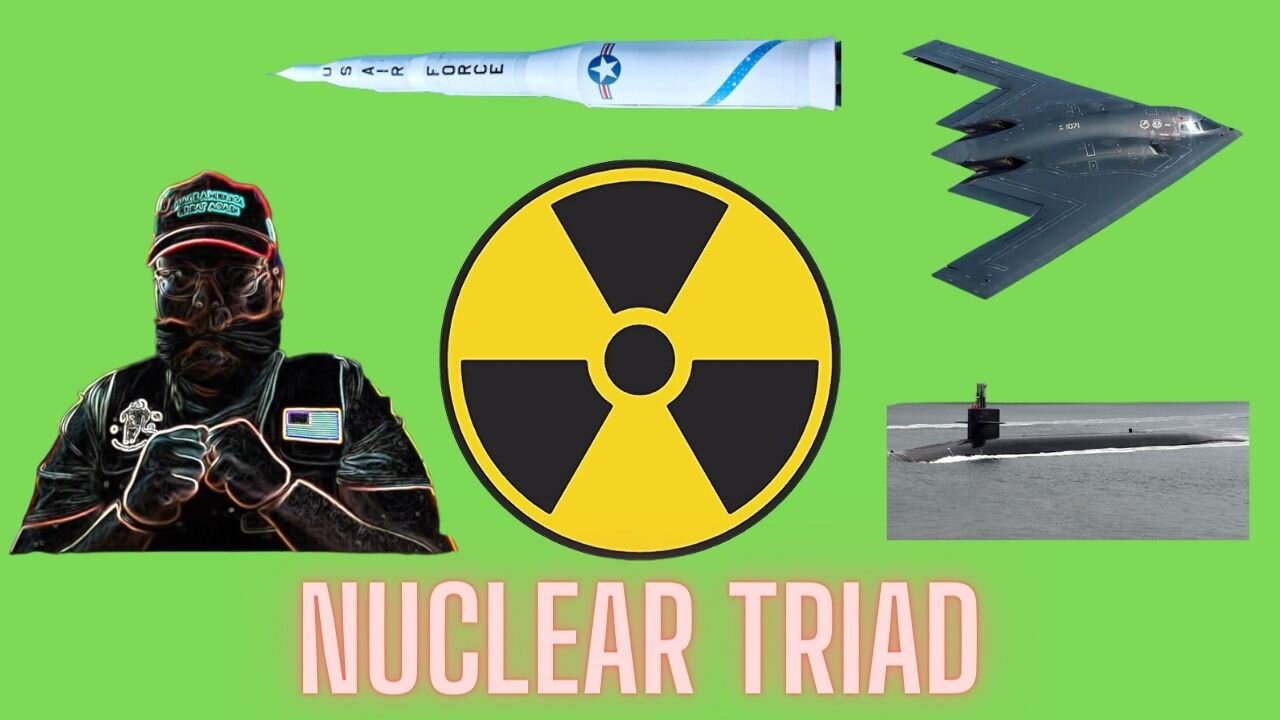Premium Only Content

America's Nuclear Triad - Science and Tech Tuesday
The U.S. nuclear arsenal comprises thousands of nuclear weapons and three methods of delivery, sometimes called “legs.” Warheads can be launched from the air via strategic bombers carrying gravity bombs or cruise missiles, from the sea by submarines holding ballistic missiles, or from underground silos housing intercontinental ballistic missiles. Collectively, these delivery methods are referred to as “the Triad.” Currently all three legs of the Triad are being modernized at a cost of $494 billion, or about $50 billion every year from 2019 to 2028.
The United States has stated it must maintain all three legs of the Triad in order to support the policy of deterrence — the credible threat of retaliation if it or an ally is attacked. The argument is that the Triad enables a second-strike capability — the ability to retaliate in the event of a nuclear attack — as each leg is a hedge against the failure of another.
However, a debate has emerged among lawmakers and policy experts about whether the land-based leg of the Triad is still necessary or desirable. A recent survey found that many Americans support phasing out our land-based missiles because they are “outdated, destabilizing, and very expensive.”
How many?
The United States currently maintains around 5,800 nuclear warheads in its arsenal. Of these, about 3,800 are active warheads and 2,000 have been retired and are awaiting dismantlement. The inventory of deployed delivery systems consists of 66 bombers as well as dual-capable fighter aircrafts; 14 ballistic missile submarines; and 400 silos for intercontinental ballistic missiles.
Air
There are two distinct nuclear weapons systems delivered by plane: nuclear air-launched cruise missiles (ALCMs), which are guided and highly accurate, and gravity bombs, which require a plane to deploy them near a desired target. B-52 bombers carry nuclear-tipped ALCMs and B-2 stealth bombers have gravity bomb capabilities. Currently there are 20 B-2s and 46 B-52s deployed.
The B-2 can carry up to 16 nuclear bombs like the B61-7, B61-11, and B83-1 gravity bombs. Each B-52 bomber carries up to 20 ALCMs like the AGM-86B.
Current nuclear modernization plans include continued production of a new gravity bomb (B61-12) and a new nuclear cruise missile known as the Long Range Standoff Weapon (LRSO). The Air Force is also designing the B-21 “Raider” to replace the B-2 and B-52s, as well as the F-35 to replace the F-16 as the United States’ key nuclear-capable fighter aircraft.
Sea
The sea leg of the Triad currently consists of 14 Ohio-class ballistic missile submarines (SSBNs). These submarines are capable of firing ballistic missiles from submerged positions to hit an intended target. Current U.S. SSBNs can launch up to 20 nuclear-capable ballistic missiles with multiple warheads per missile. The Trident II D5 missile is the latest generation SSBN and can travel more than 7,000 kilometers. The sea leg of the triad is often considered the most essential, since submarines are difficult to track and destroy.
The Ohio-class SSBNs will be replaced by the Columbia-class SSBN in the early 2030s and includes 12 scheduled submarines slotted for production. As of now, this modernization will cost around $109.8 billion.
Ground
The Triad’s land-based leg is composed of 400 deployed Minuteman III intercontinental ballistic missiles (ICBMs). U.S. ICBMs are housed in underground silos in Montana, North Dakota and Wyoming, but silos stretch into Colorado and Nebraska as well. Each ICBM carries one warhead each — usually the W87 or the W78 — but can hold two or three warheads each. ICBMs remain on prompt alert, meaning they can be launched in minutes.
Nuclear modernization plans include a replacement for the Minuteman III called the Ground-Based Strategic Deterrent, and includes 400 new deployed missiles, modernization of the ICBM launch facilities and a total lifetime price tag of about $264 billion.
The static nature of ICBM silos makes them vulnerable to attack and increases the risk of miscalculation. If the United States detects an incoming attack or what looks like an incoming attack, there is psychological pressure to launch the ICBMs before they can be destroyed in their silos — a sort of “use them or lose them” mentality. It is the combination of the vulnerability of ICBMs, the risk of miscalculation and the replacement cost that leads some experts to argue that the United States no longer needs a land-based nuclear weapon system.
-
 1:36:05
1:36:05
Side Scrollers Podcast
19 hours agoStreamer ATTACKS Men Then Cries Victim + Pronoun Rant Anniversary + More | Side Scrollers
80.4K4 -
 LIVE
LIVE
Lofi Girl
2 years agoSynthwave Radio 🌌 - beats to chill/game to
271 watching -
 42:55
42:55
Stephen Gardner
1 day ago🔥Trump’s SURPRISE Move STUNS Everyone - Democrats PANIC!
102K124 -
 1:37:19
1:37:19
Badlands Media
16 hours agoBaseless Conspiracies Ep. 148: The Delphi Murders – Secrets, Setups, and Cover-Ups
47.1K18 -
 5:59:05
5:59:05
SpartakusLIVE
10 hours ago#1 MACHINE Never Stops The GRIND || LAST Stream UNTIL Friday
152K3 -
 28:36
28:36
Afshin Rattansi's Going Underground
1 day agoDoug Bandow: ENORMOUS DAMAGE Done to US’ Reputation Over Gaza, Trump ‘Easily Manipulated’ by Israel
33.4K34 -
 2:45:13
2:45:13
Barry Cunningham
17 hours agoCBS CAUGHT AGAIN! CHICAGO A MESS! LISA COOK IS COOKED AND MORE LABOR DAY NEWS!
122K51 -
 6:39:17
6:39:17
StevieTLIVE
11 hours agoMASSIVE Warzone Wins on Labor Day w/ Spartakus
37.9K1 -
 10:46:42
10:46:42
Rallied
17 hours ago $18.70 earnedWarzone Challenges w/ Doc & Bob
204K4 -
 3:26:25
3:26:25
Joe Donuts Live
10 hours ago🟢 Lost in Space with My Clones: The Alters Adventure Begins
40.2K5